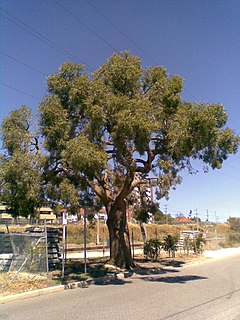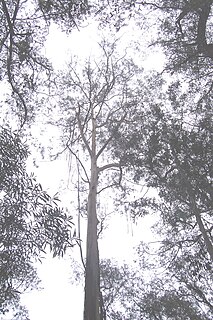
Eucalyptus ovata, commonly known as swamp gum or black gum, is a small to medium-sized tree species that is endemic to south-eastern Australia. It has mostly smooth bark, glossy green, lance-shaped to egg-shaped adult leaves, green flower buds in groups of seven, white flowers and conical to bell-shaped fruit.

Eucalyptus youngiana, commonly known as large-fruited mallee, Ooldea mallee and yarldarlba, is a species of mallee, less commonly a tree, that in native to arid and semi-arid areas of southern Western Australia and South Australia. It has rough, fibrous bark on some or all of the trunk, smooth bark above, lance-shaped adult leaves, flower buds in groups of three, red, pink or bright yellow flowers and short, broad, conical fruit.

Eucalyptus moluccana, commonly known as the grey box, gum-topped box or terriyergro, is a medium-sized to tall tree with rough bark on part or all of the trunk, smooth bark above, lance-shaped adult leaves, flower buds usually in groups of seven, white flowers and cup-shaped to barrel-shaped fruit. It is found in near-coastal areas of Queensland and New South Wales.

Eucalyptus dumosa, commonly known as the white mallee, dumosa mallee, or Congoo mallee, is a species of mallee that is endemic to south eastern Australia. It usually has rough, flaky grey bark on the lower trunk, smooth bark above, lance-shaped to curved adult leaves, flower buds in groups of seven, white flowers and cup-shaped, cylindrical or barrel-shaped fruit.

Eucalyptus todtiana, commonly known as coastal blackbuttpricklybark or dwutta, is a species of tree or a mallee that is endemic to the west coast of Western Australia. It has rough, fibrous and flaky bark on the trunk, smooth bark on the branches, lance-shaped adult leaves, flower buds in groups of between seven and eleven, white flowers and cup-shaped to hemispherical fruit.

Eucalyptus smithii, commonly known as the gully gum, gully peppermint, blackbutt peppermint, or ironbark peppermint, is a species of medium-sized to tall tree, sometimes a mallee, that is endemic to southeastern Australia. It has rough, compact bark on the trunk, smooth ribbony bark above, narrow lance-shaped adult leaves, flower buds in groups of seven, white flowers and cup-shaped, bell-shaped or hemispherical fruit.

Eucalyptus consideniana, commonly known as yertchuk, is a species of plant in the myrtle family and is endemic to south-eastern Australia. It is a tree with rough, fibrous, sometimes prickly bark on the trunk and larger branches, smooth grey bark above, lance-shaped or curved adult leaves, flower buds in groups of between eleven and nineteen, white flowers and conical to hemispherical fruit.

Eucalyptus intertexta, commonly known as inland red box, western red box, gum coolibah or the bastard coolibah, is a species of tree that is endemic to central Australia. It has rough, fibrous or flaky bark on the base of the trunk, smooth white to brownish bark above, lance-shaped adult leaves, flower buds in groups of seven on the ends of branchlets, white flowers and cup-shaped to hemispherical fruit.

Eucalyptus comitae-vallis, commonly known as Comet Vale mallee, is a mallee that is endemic to the south-west of Western Australia. It has rough, flaky to ribbony bark on the trunk and larger branches, smooth withish bark above, linear to narrow lance-shaped adult leaves, flower buds in groups of seven to eleven, white flowers and barrel-shaped, conical or cup-shaped fruit.

Eucalyptus cooperiana, commonly known as the many-flowered mallee, is a species of mallee that is endemic to an area along the south coast of Western Australia. It is described as being "of striking appearance by reason of its smooth, white bark and acutely angled branchlets". It has lance-shaped adult leaves, flower buds in groups of between nine and thirteen or more, creamy yellow flowers and urn-shaped fruit.

Eucalyptus kessellii, commonly known as Jerdacuttup mallee, is a species of mallee that is endemic to an area along the south coast of Western Australia. It has very hard, rough bark on the trunk of larger specimens, smooth greyish and brownish bark above, lance-shaped to egg-shaped adult leaves, flower buds in groups of three or seven, creamy white flowers and downturned, conical to cup-shaped fruit.

Eucalyptus platycorys, commonly known as Boorabbin mallee, is a species of mallee, rarely a small tree, that is endemic to Western Australia. It has rough, dark grey, fibrous and flaky bark on the trunk, smooth greyish bark above, lance-shaped adult leaves, flower buds usually in group of three, creamy white flowers and cup-shaped to cylindrical fruit.
Eucalyptus pruiniramis, commonly known as Jingymia gum or midlands gum is a species of mallee or tree that is endemic to a small area of Western Australia. It usually has rough bark on the lower half of the trunk, smooth bark above, dull green, lance-shaped adult leaves, flower buds in groups of between seven and eleven, white flowers and cylindrical to cup-shaped fruit.
Eucalyptus semota, commonly known as marymia mallee, is a species of mallee or small tree that is endemic to a small area in central Western Australia. It has rough, flaky to fibrous bark on the trunk, smooth grey or brown bark above, linear to narrow lance-shaped leaves, flower buds in groups of seven or nine, white flowers and conical to cup-shaped fruit.

Eucalyptus striaticalyx, commonly known as Cue York gum or kopi gum, is a species of tree or mallee that is endemic to Western Australia. It has thick, rough, fibrous bark on the trunk and larger branches, lance-shaped adult leaves, flower buds in groups of between seven and thirteen, creamy white flowers and conical to cup-shaped fruit.

Eucalyptus yilgarnensis, commonly known as yorrell or yorrel, is a species of mallee, rarely a small tree, that is endemic to Western Australia. It usually has rough bark on the trunk, smooth bark above, linear to narrow elliptical or narrow lance-shaped adult leaves, flower buds in groups of seven or nine, white flowers and barrel-shaped fruit.

Eucalyptus bakeri, commonly known as Baker's mallee or the mallee box, is a eucalypt that is endemic to eastern Australia. It has fibrous bark on the trunk and smooth white or grey bark above, narrow lance-shaped leaves, flower buds in groups of between seven and thirteen, white flowers and hemispherical or shortened spherical fruit.

Eucalyptus crucis is a species of mallee that is endemic to Western Australia. There are three subspecies, commonly known as silver mallee or Southern Cross mallee,, narrow-leaved silver mallee, and Paynes Find mallee,. It has rough bark that is shed in curling flakes, more or less round, glaucous juvenile leaves, egg-shaped intermediate leaves and lance-shaped adult leaves. The type of bark and the proportion of juvenile, intermediate and adult leaves in the crown of mature plants varies with subspecies. The flower buds are arranged in groups of seven in leaf axils, the flowers are whitish to pale yellow and the fruit is a conical to hemispherical capsule.

Eucalyptus neglecta, commonly known as Omeo gum, is a species of small tree that is endemic to a small area of Victoria, Australia. Older plants have rough, fibrous bark on the trunk, otherwise smooth grey to brownish bark, a crown of mostly lance-shaped, egg-shaped or oblong leaves arranged in opposite pairs, flower buds in groups of between seven and fifteen, white flowers and cup-shaped or conical fruit.

Eucalyptus alaticaulis, commonly known as the Grampians grey-gum, is a tree or mallee that is endemic to a restricted area in the Grampians National Park in Australia. It has rough, fibrous bark near the base of its trunk, lance-shaped leaves, groups of about seven cylindrical buds with a cone-shaped operculum, white flowers and more or less cylindrical fruit.





















